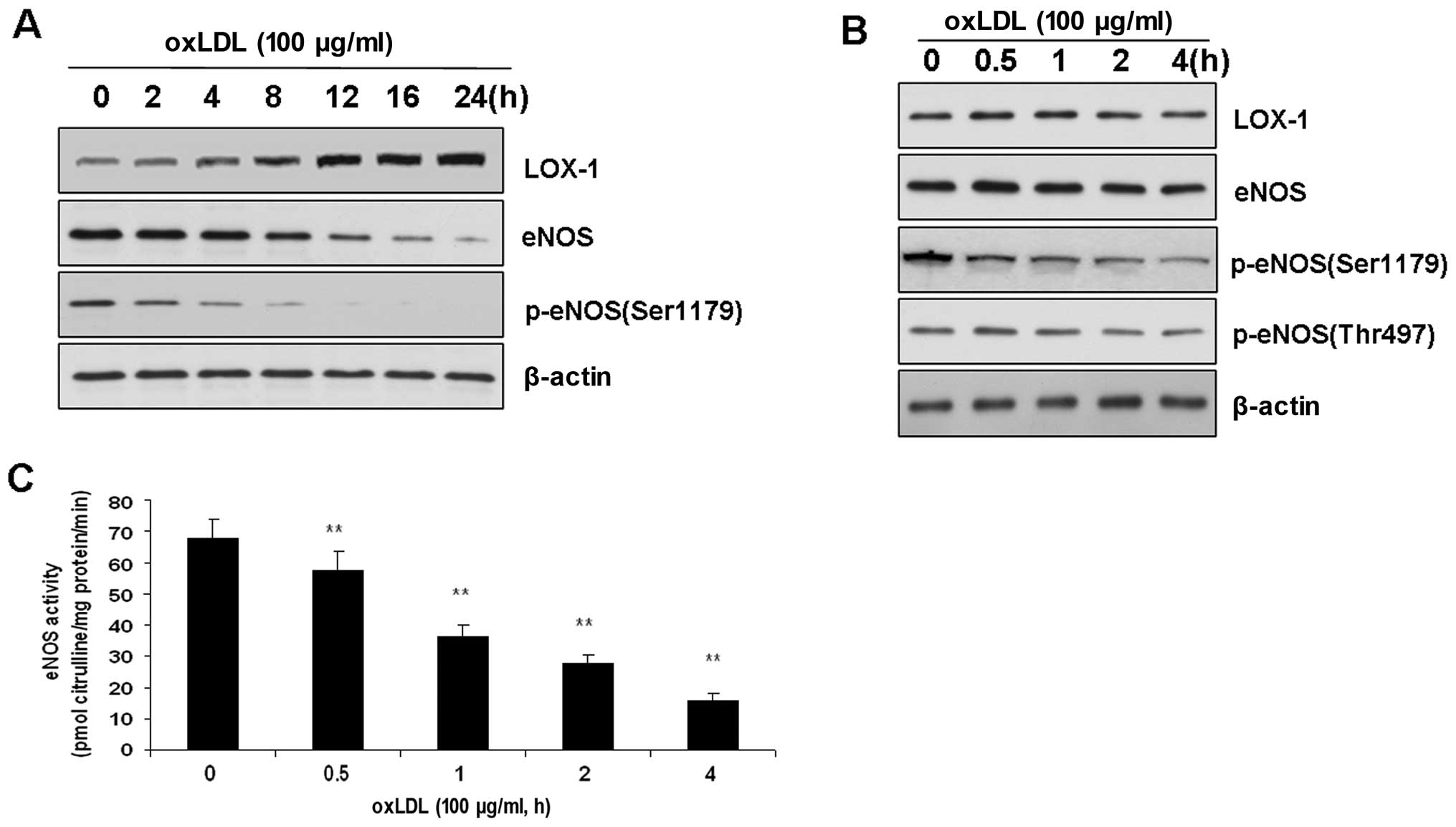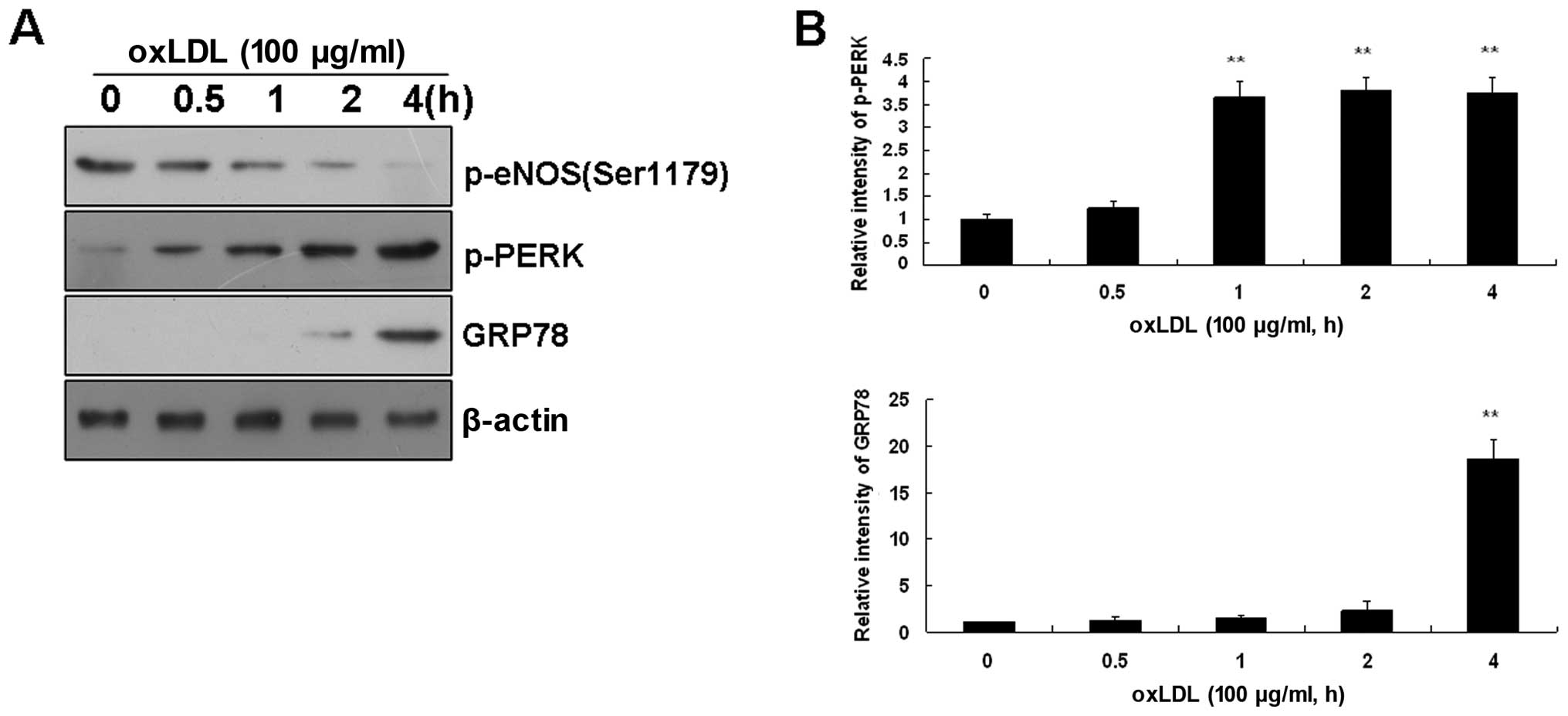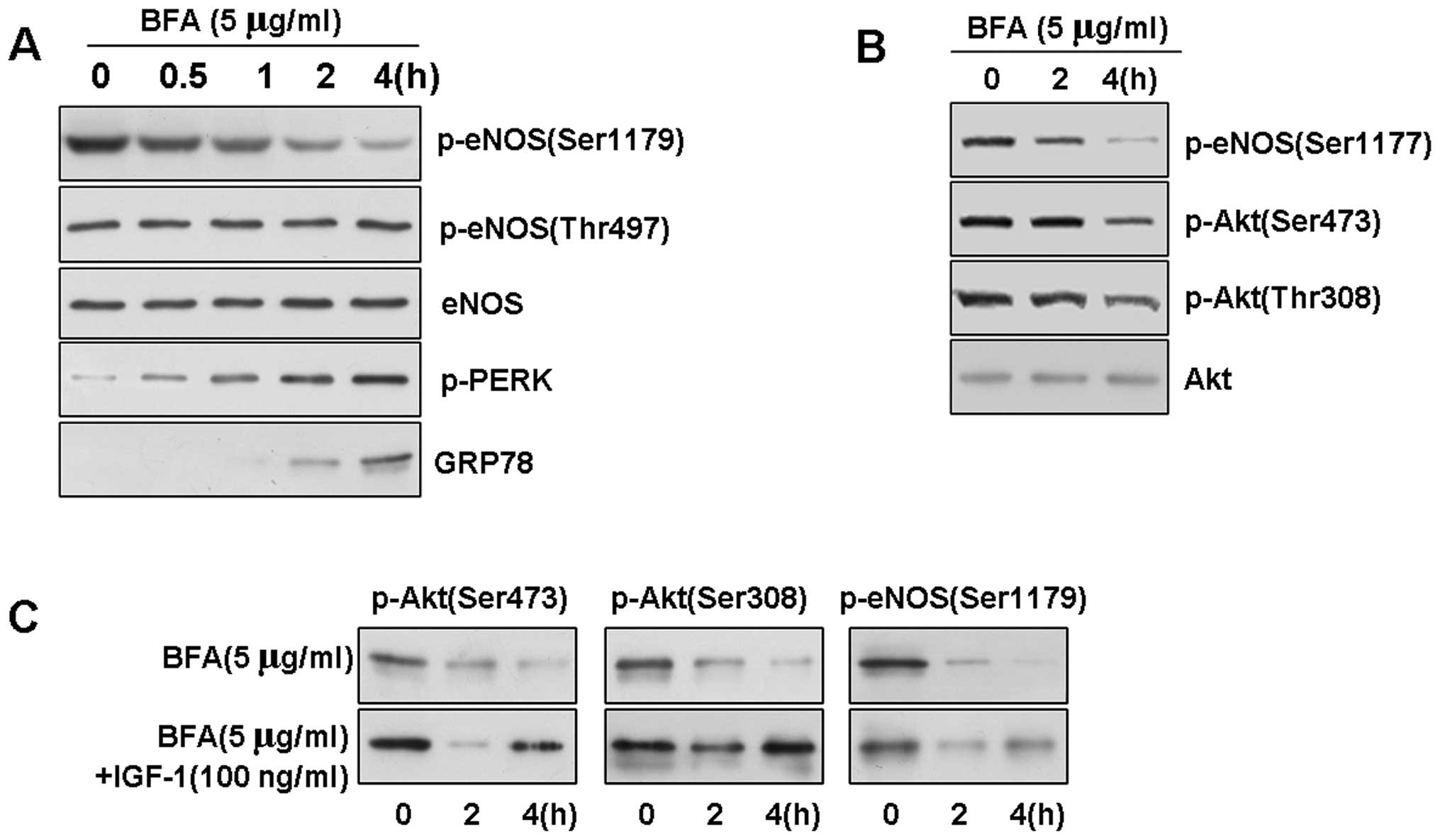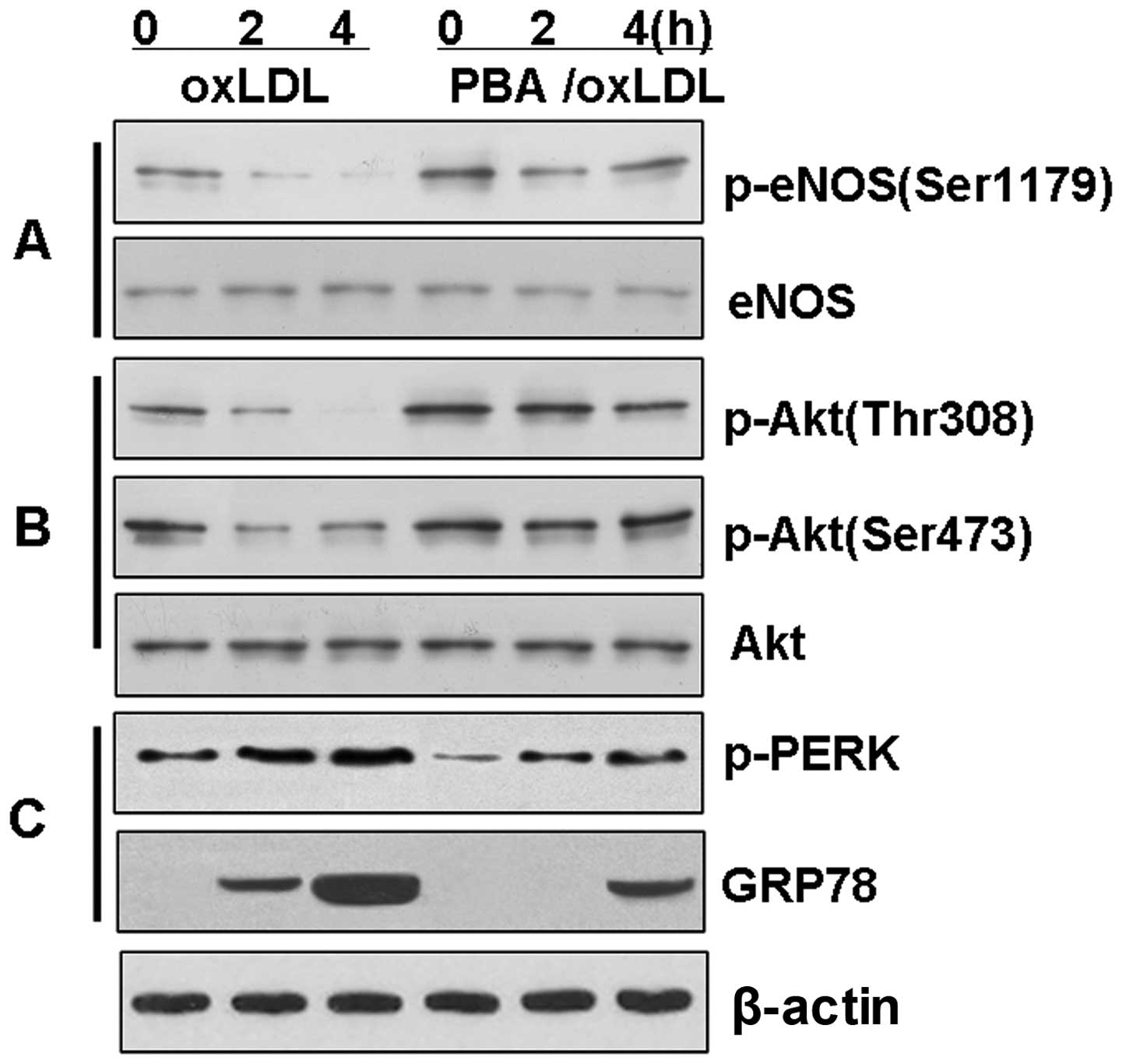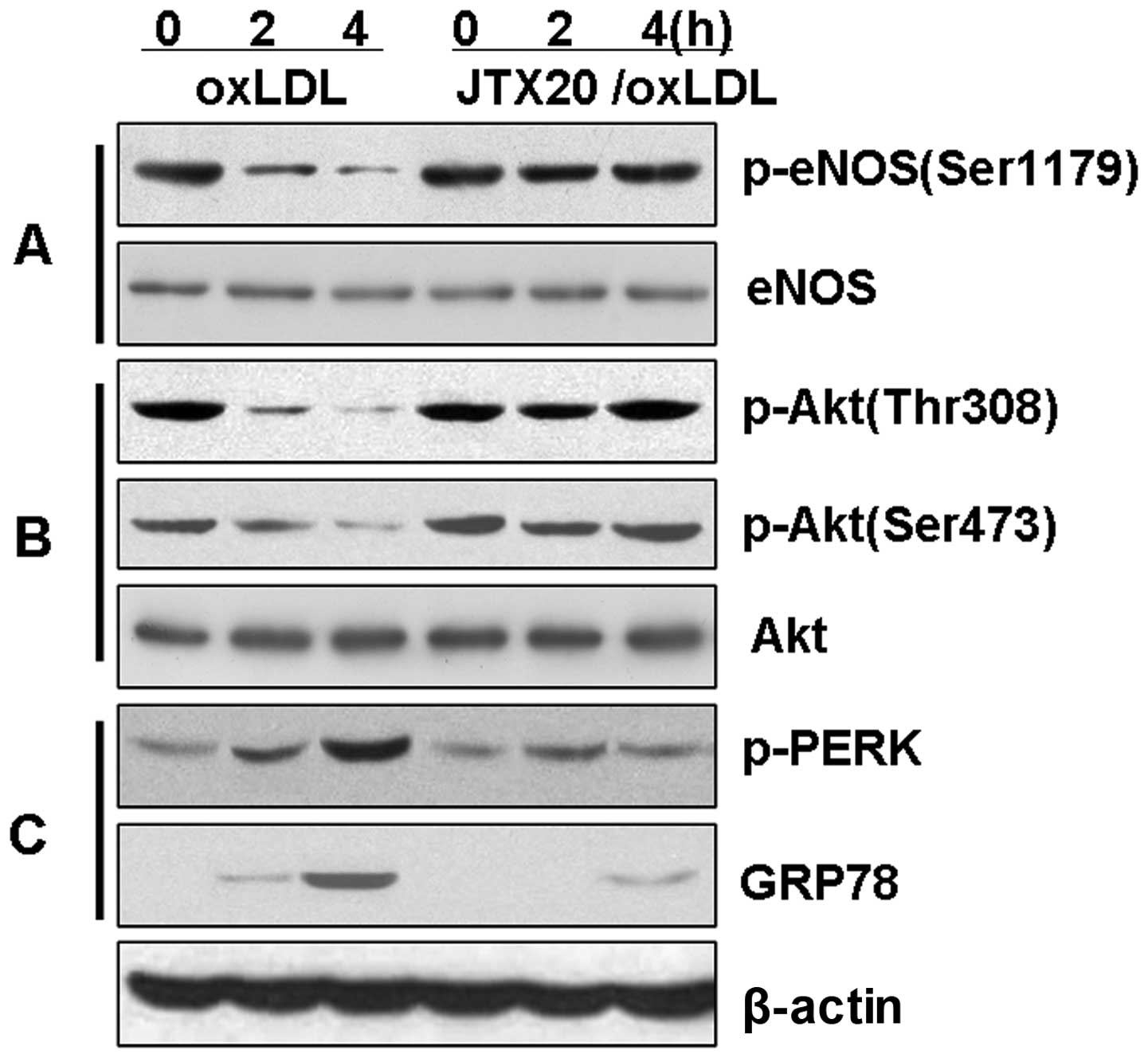|
1
|
Ross R: The pathogenesis of
atherosclerosis: a perspective for the 1990s. Nature. 362:801–809.
1993. View
Article : Google Scholar : PubMed/NCBI
|
|
2
|
Stocker R and Keaney JF Jr: Role of
oxidative modifications in atherosclerosis. Physiol Rev.
84:1381–1478. 2004. View Article : Google Scholar : PubMed/NCBI
|
|
3
|
Griffith OW and Stuehr DJ: Nitric oxide
synthases: properties and catalytic mechanism. Annu Rev Physiol.
57:707–736. 1995. View Article : Google Scholar : PubMed/NCBI
|
|
4
|
Cheng J, Ou JS, Singh H, et al:
20-hydroxyeicosatetraenoic acid causes endothelial dysfunction via
eNOS uncoupling. Am J Physiol Heart Circ Physiol. 294:H1018–H1026.
2008. View Article : Google Scholar : PubMed/NCBI
|
|
5
|
Sawamura T, Kume N, Aoyama T, et al: An
endothelial receptor for oxidized low-density lipoprotein. Nature.
386:73–77. 1997. View
Article : Google Scholar : PubMed/NCBI
|
|
6
|
Sugimoto K, Ishibashi T, Sawamura T, et
al: LOX-1-MT1-MMP axis is crucial for RhoA and Rac1 activation
induced by oxidized low-density lipoprotein in endothelial cells.
Cardiovasc Res. 84:127–136. 2009. View Article : Google Scholar : PubMed/NCBI
|
|
7
|
Ogura S, Kakino A, Sato Y, et al: Lox-1:
the multifunctional receptor underlying cardiovascular dysfunction.
Circ J. 73:1993–1999. 2009. View Article : Google Scholar : PubMed/NCBI
|
|
8
|
Fulton D, Gratton JP, McCabe TJ, et al:
Regulation of endothelium-derived nitric oxide production by the
protein kinase Akt. Nature. 399:597–601. 1999. View Article : Google Scholar : PubMed/NCBI
|
|
9
|
Dimmeler S, Fleming I, Fisslthaler B, et
al: Activation of nitric oxide synthase in endothelial cells by
Akt-dependent phosphorylation. Nature. 399:601–605. 1999.
View Article : Google Scholar : PubMed/NCBI
|
|
10
|
Sanson M, Auge N, Vindis C, et al:
Oxidized low-density lipoproteins trigger endoplasmic reticulum
stress in vascular cells: prevention by oxygen-regulated protein
150 expression. Circ Res. 104:328–336. 2009. View Article : Google Scholar
|
|
11
|
Tu BP and Weissman JS: Oxidative protein
folding in eukaryotes: mechanisms and consequences. J Cell Biol.
164:341–346. 2004. View Article : Google Scholar : PubMed/NCBI
|
|
12
|
Banhegyi G, Csala M, Szarka A, et al: Role
of ascorbate in oxidative protein folding. Biofactors. 17:37–46.
2003. View Article : Google Scholar : PubMed/NCBI
|
|
13
|
Zhou J, Werstuck GH, Lhotak S, et al:
Association of multiple cellular stress pathways with accelerated
atherosclerosis in hyperhomocysteinemic apolipoprotein E-deficient
mice. Circulation. 110:207–213. 2004. View Article : Google Scholar : PubMed/NCBI
|
|
14
|
Myoishi M, Hao H, Minamino T, et al:
Increased endoplasmic reticulum stress in atherosclerotic plaques
associated with acute coronary syndrome. Circulation.
116:1226–1233. 2007. View Article : Google Scholar : PubMed/NCBI
|
|
15
|
Xu C, Bailly-Maitre B and Reed JC:
Endoplasmic reticulum stress: cell life and death decisions. J Clin
Invest. 115:2656–2664. 2005. View
Article : Google Scholar : PubMed/NCBI
|
|
16
|
Dong Y, Zhang M, Liang B, et al: Reduction
of AMP-activated protein kinase alpha2 increases endoplasmic
reticulum stress and atherosclerosis in vivo. Circulation.
121:792–803. 2010. View Article : Google Scholar : PubMed/NCBI
|
|
17
|
Hyoda K, Hosoi T, Horie N, et al: PI3K-Akt
inactivation induced CHOP expression in endoplasmic
reticulum-stressed cells. Biochem Biophys Res Commun. 340:286–290.
2006. View Article : Google Scholar : PubMed/NCBI
|
|
18
|
Sessa WC, Harrison JK, Luthin DR, et al:
Genomic analysis and expression patterns reveal distinct genes for
endothelial and brain nitric oxide synthase. Hypertension.
21:934–938. 1993. View Article : Google Scholar : PubMed/NCBI
|
|
19
|
Sessa WC, Barber CM and Lynch KR: Mutation
of N-myristoylation site converts endothelial cell nitric oxide
synthase from a membrane to a cytosolic protein. Circ Res.
72:921–924. 1993. View Article : Google Scholar : PubMed/NCBI
|
|
20
|
Rosenkranz-Weiss P, Sessa WC, Milstien S,
et al: Regulation of nitric oxide synthesis by proinflammatory
cytokines in human umbilical vein endothelial cells. Elevations in
tetrahydrobiopterin levels enhance endothelial nitric oxide
synthase specific activity. J Clin Invest. 93:2236–2243. 1994.
View Article : Google Scholar
|
|
21
|
Wei Q and Xia Y: Proteasome inhibition
down-regulates endothelial nitric-oxide synthase phosphorylation
and function. J Biol Chem. 281:21652–21659. 2006. View Article : Google Scholar : PubMed/NCBI
|
|
22
|
Doms RW, Lamb RA, Rose JK and Helenius A:
Folding and assembly of viral membrane proteins. Virology.
193:545–562. 1993. View Article : Google Scholar : PubMed/NCBI
|
|
23
|
Greif DM, Kou R and Michel T:
Site-specific dephosphorylation of endothelial nitric oxide
synthase by protein phosphatase 2A: evidence for crosstalk between
phosphorylation sites. Biochemistry. 41:15845–15853. 2002.
View Article : Google Scholar
|
|
24
|
Millward TA, Zolnierowicz S and Hemmings
BA: Regulation of protein kinase cascades by protein phosphatase
2A. Trends Biochem Sci. 24:186–191. 1999. View Article : Google Scholar : PubMed/NCBI
|
|
25
|
Kaufman RJ: Stress signaling from the
lumen of the endoplasmic reticulum: coordination of gene
transcriptional and translational controls. Genes Dev.
13:1211–1233. 1999. View Article : Google Scholar : PubMed/NCBI
|
|
26
|
Mehta JL, Li DY, Chen HJ, et al:
Inhibition of LOX-1 by statins may relate to upregulation of eNOS.
Biochem Biophys Res Commun. 289:857–861. 2001. View Article : Google Scholar : PubMed/NCBI
|
|
27
|
Aoyama T, Sawamura T, Furutani Y, et al:
Structure and chromosomal assignment of the human lectin-like
oxidized low-density-lipoprotein receptor-1 (LOX-1) gene. Biochem
J. 339:177–184. 1999. View Article : Google Scholar : PubMed/NCBI
|
|
28
|
Li D, Yang B and Mehta JL: Ox-LDL induces
apoptosis in human coronary artery endothelial cells: role of PKC,
PTK, bcl-2, and Fas. Am J Physiol. 275:H568–H576. 1998.PubMed/NCBI
|
|
29
|
Li D and Mehta JL: Upregulation of
endothelial receptor for oxidized LDL (LOX-1) by oxidized LDL and
implications in apoptosis of human coronary artery endothelial
cells: evidence from use of antisense LOX-1 mRNA and chemical
inhibitors. Arterioscler Thromb Vasc Biol. 20:1116–1122. 2000.
View Article : Google Scholar : PubMed/NCBI
|
|
30
|
Oka K, Sawamura T, Kikuta K, et al:
Lectin-like oxidized low-density lipoprotein receptor 1 mediates
phagocytosis of aged/apoptotic cells in endothelial cells. Proc
Natl Acad Sci USA. 95:9535–9540. 1998. View Article : Google Scholar : PubMed/NCBI
|
|
31
|
Mehta JL and Li DY: Identification and
autoregulation of receptor for OX-LDL in cultured human coronary
artery endothelial cells. Biochem Biophys Res Commun. 248:511–514.
1998. View Article : Google Scholar : PubMed/NCBI
|
|
32
|
Shiojima I and Walsh K: Role of Akt
signaling in vascular homeostasis and angiogenesis. Circ Res.
90:1243–1250. 2002. View Article : Google Scholar : PubMed/NCBI
|
|
33
|
Wang X and Robbins J: Heart failure and
protein quality control. Circ Res. 99:1315–1328. 2006. View Article : Google Scholar : PubMed/NCBI
|
|
34
|
Glembotski CC: Endoplasmic reticulum
stress in the heart. Circ Res. 101:975–984. 2007. View Article : Google Scholar
|
|
35
|
Lai E, Teodoro T and Volchuk A:
Endoplasmic reticulum stress: signaling the unfolded protein
response. Physiology (Bethesda). 22:193–201. 2007. View Article : Google Scholar : PubMed/NCBI
|
|
36
|
Schroder M and Kaufman RJ: The mammalian
unfolded protein response. Annu Rev Biochem. 74:739–789. 2005.
View Article : Google Scholar
|
|
37
|
Yamaguchi H and Wang HG: CHOP is involved
in endoplasmic reticulum stress-induced apoptosis by enhancing DR5
expression in human carcinoma cells. J Biol Chem. 279:45495–45502.
2004. View Article : Google Scholar : PubMed/NCBI
|
|
38
|
Ma Y, Brewer JW, Diehl JA and Hendershot
LM: Two distinct stress signaling pathways converge upon the CHOP
promoter during the mammalian unfolded protein response. J Mol
Biol. 318:1351–1365. 2002. View Article : Google Scholar : PubMed/NCBI
|
|
39
|
Ron D and Habener JF: CHOP, a novel
developmentally regulated nuclear protein that dimerizes with
transcription factors C/EBP and LAP and functions as a
dominant-negative inhibitor of gene transcription. Genes Dev.
6:439–453. 1992. View Article : Google Scholar : PubMed/NCBI
|



